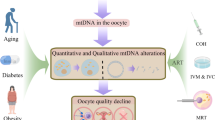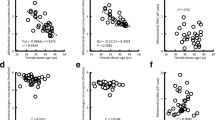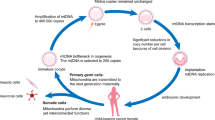Abstract
Coenzyme Q10 (CoQ10) is a natural component widely present in the inner membrane of mitochondria. CoQ10 functions as a key cofactor for adenosine triphosphate (ATP) production and exhibits antioxidant properties in vivo. Mitochondria, as the energy supply center of cells, play a crucial role in germ cell maturation and embryonic development, a complicated process of cell division and cellular differentiation that transforms from a single cell (zygote) to a multicellular organism (fetus). Here, we discuss the effects of CoQ10 on oocyte maturation and the important role of CoQ10 in the growth of various organs during different stages of fetal development. These allowed us to gain a deeper understanding of the pathophysiology of embryonic development and the potential role of CoQ10 in improving fertility quality. They also provide a reference for further developing its application in clinical treatments.



Similar content being viewed by others
Data availability
Not applicable.
References
Wang L, Sang Q. MOS is a novel genetic marker for human early embryonic arrest and fragmentation. EMBO Mol Med. 2021;13(12):e15323.
Xu Y, et al. Mutations in PADI6 cause female infertility characterized by early embryonic arrest. Am J Hum Genet. 2016;99(3):744–52.
Van den Veyver IB, Al-Hussaini TK. Biparental hydatidiform moles: a maternal effect mutation affecting imprinting in the offspring. Hum Reprod Update. 2006;12(3):233–42.
Zhao J, et al. Metabolic remodelling during early mouse embryo development. Nat Metab. 2021;3(10):1372–84.
Wang M, et al. Autophagy: a multifaceted player in the fate of sperm. Hum Reprod Update. 2022;28(2):200–31.
Gott AL, et al. Non-invasive measurement of pyruvate and glucose uptake and lactate production by single human preimplantation embryos. Hum Reprod. 1990;5(1):104–8.
Rossmann MP, et al. Cell-specific transcriptional control of mitochondrial metabolism by TIF1gamma drives erythropoiesis. Science. 2021;372(6543):716–21.
You X, et al. Embryonic expression of Nras(G 12 D) leads to embryonic lethality and cardiac defects. Front Cell Dev Biol. 2021;9: 633661.
Wu YD Yang, and GY Chen. Targeted disruption of Rab1a causes early embryonic lethality. Int J Mol Med. 2022;49(4):46.
Drovandi S, et al. Variation of the clinical spectrum and genotype-phenotype associations in coenzyme Q10 deficiency associated glomerulopathy. Kidney Int. 2022;102(3):592–603.
Griffiths KK, et al. Inefficient thermogenic mitochondrial respiration due to futile proton leak in a mouse model of fragile X syndrome. FASEB J. 2020;34(6):7404–26.
Ogasahara S, et al. Treatment of Kearns-Sayre syndrome with coenzyme Q10. Neurology. 1986;36(1):45–53.
Pallotti F et al. The roles of coenzyme Q in disease: direct and indirect involvement in cellular functions. Int J Mol Sci. 2021;23(1):128.
Gutierrez-Mariscal FM et al. Coenzyme Q(10) Supplementation for the reduction of oxidative stress: clinical implications in the treatment of chronic diseases. Int J Mol Sci. 2020;21(21):7870.
Wang Y, Hekimi S. Understanding ubiquinone. Trends Cell Biol. 2016;26(5):367–78.
Lapuente-Brun E, et al. Supercomplex assembly determines electron flux in the mitochondrial electron transport chain. Science. 2013;340(6140):1567–70.
Stefely JA, Pagliarini DJ. Biochemistry of mitochondrial coenzyme Q biosynthesis. Trends Biochem Sci. 2017;42(10):824–43.
Alcazar-Fabra M, et al. Primary coenzyme Q deficiencies: a literature review and online platform of clinical features to uncover genotype-phenotype correlations. Free Radic Biol Med. 2021;167:141–80.
Zhao M, et al. L-shaped association between dietary coenzyme Q10 intake and high-sensitivity C-reactive protein in Chinese adults: a national cross-sectional study. Food Funct. 2023;14(21):9815–24.
Paredes-Fuentes AJ et al. Coenzyme Q(10) Treatment monitoring in different human biological samples. Antioxidants (Basel). 2020;9(10):979.
Griffiths KKA Wang, and RJ Levy. Assessment of open probability of the mitochondrial permeability transition pore in the setting of coenzyme Q excess. J Vis Exp. 2022(184):10.3791/63646.
Barajas M, et al. The newborn Fmr1 knockout mouse: a novel model of excess ubiquinone and closed mitochondrial permeability transition pore in the developing heart. Pediatr Res. 2021;89(3):456–63.
Chazaud C, et al. Early lineage segregation between epiblast and primitive endoderm in mouse blastocysts through the Grb2-MAPK pathway. Dev Cell. 2006;10(5):615–24.
Gauster M, et al. Early human trophoblast development: from morphology to function. Cell Mol Life Sci. 2022;79(6):345.
Gardner RL, Rossant J. Investigation of the fate of 4–5 day post-coitum mouse inner cell mass cells by blastocyst injection. J Embryol Exp Morphol. 1979;52:141–52.
Lawson KA and RA Pedersen. Clonal analysis of cell fate during gastrulation and early neurulation in the mouse. Ciba Found Symp, 1992;165:3–21.
Smith JL, Schoenwolf GC. Neurulation: coming to closure. Trends Neurosci. 1997;20(11):510–7.
Tam PP, Tan SS. The somitogenetic potential of cells in the primitive streak and the tail bud of the organogenesis-stage mouse embryo. Development. 1992;115(3):703–15.
Wardle FC. Mesoderm differentiation in vertebrate development and regenerative medicine. Semin Cell Dev Biol. 2022;127:1–2.
Adhikari D, et al. Oocyte mitochondria-key regulators of oocyte function and potential therapeutic targets for improving fertility. Biol Reprod. 2022;106(2):366–77.
Santos TA, El Shourbagy S, St John JC. Mitochondrial content reflects oocyte variability and fertilization outcome. Fertil Steril. 2006;85(3):584–91.
Van Blerkom J. Mitochondria in human oogenesis and preimplantation embryogenesis: engines of metabolism, ionic regulation and developmental competence. Reproduction. 2004;128(3):269–80.
Tarazona AM, et al. Mitochondrial activity, distribution and segregation in bovine oocytes and in embryos produced in vitro. Reprod Domest Anim. 2006;41(1):5–11.
Czernik M, et al. Author correction: mitochondrial function and intracellular distribution is severely affected in in vitro cultured mouse embryos. Sci Rep. 2022;12(1):21276.
Marchante M, et al. Deciphering reproductive aging in women using a NOD/SCID mouse model for distinct physiological ovarian phenotypes. Aging (Albany NY). 2023;15(20):10856–74.
He J, et al. Theaflavin 3, 3’-digallate delays ovarian aging by improving oocyte quality and regulating granulosa cell function. Oxid Med Cell Longev. 2021;2021:7064179.
Qin X, et al. TrkB agonist antibody ameliorates fertility deficits in aged and cyclophosphamide-induced premature ovarian failure model mice. Nat Commun. 2022;13(1):914.
van der Reest J, et al. Mitochondria: their relevance during oocyte ageing. Ageing Res Rev. 2021;70:101378.
Jiang Z, Shen H. Mitochondria: emerging therapeutic strategies for oocyte rescue. Reprod Sci. 2022;29(3):711–22.
Perez GI, et al. Mitochondria and the death of oocytes. Nature. 2000;403(6769):500–1.
Zhang H, et al. Melatonin improves the quality of maternally aged oocytes by maintaining intercellular communication and antioxidant metabolite supply. Redox Biol. 2022;49:102215.
Liu J, et al. Transcriptomic responses of porcine cumulus cells to heat exposure during oocytes in vitro maturation. Mol Reprod Dev. 2021;88(1):43–54.
Hu Y, et al. Transcriptomic profiles reveal the characteristics of oocytes and cumulus cells at GV, MI, and MII in follicles before ovulation. J Ovarian Res. 2023;16(1):225.
Babayev E, Duncan FE. Age-associated changes in cumulus cells and follicular fluid: the local oocyte microenvironment as a determinant of gamete quality. Biol Reprod. 2022;106(2):351–65.
Da Luz CM, et al. Altered transcriptome in cumulus cells of infertile women with advanced endometriosis with and without endometrioma. Reprod Biomed Online. 2021;42(5):952–62.
Ma Y, et al. Corrigendum: arachidonic acid in follicular fluid of PCOS induces oxidative stress in a human ovarian granulosa tumor cell line (KGN) and upregulates GDF15 expression as a response. Front Endocrinol (Lausanne). 2022;13:988767.
Jochems R, et al. Follicular fluid steroid hormones and in vitro embryo development in Duroc and Landrace pigs. Theriogenology. 2022;190:15–21.
Yu L, et al. Follicular fluid steroid and gonadotropic hormone levels and mitochondrial function from exosomes predict embryonic development. Front Endocrinol (Lausanne). 2022;13:1025523.
Krawczyk K, et al. Persistent organic pollutants affect steroidogenic and apoptotic activities in granulosa cells and reactive oxygen species concentrations in oocytes in the mouse. Reprod Fertil Dev. 2023;35(3):294–305.
Barcelos IP, Haas RH. CoQ10 and aging. Biology (Basel). 2019;8(2):28.
Yang CX, et al. CoQ10 improves meiotic maturation of pig oocytes through enhancing mitochondrial function and suppressing oxidative stress. Theriogenology. 2021;159:77–86.
Giannubilo SR et al. CoQ10 supplementation in patients undergoing IVF-ET: the relationship with follicular fluid content and oocyte maturity. Antioxidants (Basel). 2018;7(10):141.
Niu YJ, et al. Ubiquinol-10 delays postovulatory oocyte aging by improving mitochondrial renewal in pigs. Aging (Albany NY). 2020;12(2):1256–71.
Brown AM, McCarthy HE. The effect of CoQ10 supplementation on ART treatment and oocyte quality in older women. Hum Fertil (Camb). 2023;26(6):1544–52.
Yang J, et al. Human follicular fluid shows diverse metabolic profiles at different follicle developmental stages. Reprod Biol Endocrinol. 2020;18(1):74.
Lee CH, et al. Coenzyme Q10 ameliorates the quality of mouse oocytes during in vitro culture. Zygote. 2022;30(2):249–57.
Yang L, et al. Systematic understanding of anti-aging effect of coenzyme Q10 on oocyte through a network pharmacology approach. Front Endocrinol (Lausanne). 2022;13:813772.
Heydarnejad A, et al. Supplementation of maturation medium with CoQ10 enhances developmental competence of ovine oocytes through improvement of mitochondrial function. Mol Reprod Dev. 2019;86(7):812–24.
Ruiz-Conca M, et al. Apoptosis and glucocorticoid-related genes mRNA expression is modulated by coenzyme Q10 supplementation during in vitro maturation and vitrification of bovine oocytes and cumulus cells. Theriogenology. 2022;192:62–72.
Gendelman M, Roth Z. Incorporation of coenzyme Q10 into bovine oocytes improves mitochondrial features and alleviates the effects of summer thermal stress on developmental competence. Biol Reprod. 2012;87(5):118.
Trapphoff T, et al. Postovulatory aging affects dynamics of mRNA, expression and localization of maternal effect proteins, spindle integrity and pericentromeric proteins in mouse oocytes. Hum Reprod. 2016;31(1):133–49.
Miao Y, et al. Nicotinamide mononucleotide supplementation reverses the declining quality of maternally aged oocytes. Cell Rep. 2020;32(5):107987.
Zielinska AP et al. Meiotic kinetochores fragment into multiple lobes upon cohesin loss in aging eggs. Curr Biol. 2019;29(22):3749–3765.
Miao Y, et al. Postovulatory aging causes the deterioration of porcine oocytes via induction of oxidative stress. FASEB J. 2018;32(3):1328–37.
Zhang M, et al. Coenzyme Q10 ameliorates the quality of postovulatory aged oocytes by suppressing DNA damage and apoptosis. Free Radic Biol Med. 2019;143:84–94.
Jeong SM, et al. SIRT4 has tumor-suppressive activity and regulates the cellular metabolic response to DNA damage by inhibiting mitochondrial glutamine metabolism. Cancer Cell. 2013;23(4):450–63.
Zeng J, et al. SIRT4 is essential for metabolic control and meiotic structure during mouse oocyte maturation. Aging Cell. 2018;17(4):e12789.
Xing X, et al. Coenzyme Q10 supplement rescues postovulatory oocyte aging by regulating SIRT4 expression. Curr Mol Pharmacol. 2022;15(1):190–203.
Ben-Meir A, et al. Coenzyme Q10 restores oocyte mitochondrial function and fertility during reproductive aging. Aging Cell. 2015;14(5):887–95.
McReynolds S et al. Impact of maternal aging on the molecular signature of human cumulus cells. Fertil Steril. 2012;98(6):1574–80.
Ben-Meir A et al. Co-enzyme Q10 supplementation rescues cumulus cells dysfunction in a maternal aging model. Antioxidants (Basel). 2019;8(3):58.
Agarwal A, et al. Male oxidative stress infertility (MOSI): proposed terminology and clinical practice guidelines for management of idiopathic male infertility. World J Mens Health. 2019;37(3):296–312.
Barrachina F, et al. Sperm acquire epididymis-derived proteins through epididymosomes. Hum Reprod. 2022;37(4):651–68.
Tourzani DA et al. Caput ligation renders immature mouse sperm motile and capable to undergo cAMP-dependent phosphorylation. Int J Mol Sci. 2021;22(19):10241.
Moustakli E et al. Sperm mitochondrial content and mitochondrial DNA to nuclear DNA ratio are associated with body mass index and progressive motility. Biomedicines. 2023;11(11):3014.
Park YJ, et al. Low sperm motility is determined by abnormal protein modification during epididymal maturation. World J Mens Health. 2022;40(3):526–35.
Park YJ, Pang MG. Mitochondrial functionality in male fertility: from spermatogenesis to fertilization. Antioxidants (Basel). 2021;10(1):98.
Chen X, et al. Identification of differentially expressed proteins between bull X and Y spermatozoa. J Proteomics. 2012;77:59–67.
Sengupta P, et al. Oxidative stress and idiopathic male infertility. Adv Exp Med Biol. 2022;1358:181–204.
Shahid M, et al. Male infertility: role of vitamin D and oxidative stress markers. Andrologia. 2021;53(8):e14147.
Liu KS, et al. Effect and mechanisms of reproductive tract infection on oxidative stress parameters, sperm DNA fragmentation, and semen quality in infertile males. Reprod Biol Endocrinol. 2021;19(1):97.
Oseguera-Lopez I et al. Perfluorooctane sulfonate (PFOS) and perfluorohexane sulfonate (PFHxS) alters protein phosphorylation, increase ROS levels and DNA fragmentation during in vitro capacitation of boar spermatozoa. Animals (Basel). 2020;10(10):1934.
Li KP, Yang XS, Wu T. The effect of antioxidants on sperm quality parameters and pregnancy rates for idiopathic male infertility: a network meta-analysis of randomized controlled trials. Front Endocrinol (Lausanne). 2022;13:810242.
Alahmar AT, et al. Coenzyme Q10 improves sperm parameters, oxidative stress markers and sperm DNA fragmentation in infertile patients with idiopathic oligoasthenozoospermia. World J Mens Health. 2021;39(2):346–51.
Balercia G, et al. Coenzyme Q10 treatment in infertile men with idiopathic asthenozoospermia: a placebo-controlled, double-blind randomized trial. Fertil Steril. 2009;91(5):1785–92.
Safarinejad MR. Efficacy of coenzyme Q10 on semen parameters, sperm function and reproductive hormones in infertile men. J Urol. 2009;182(1):237–48.
Bellusci M, et al. Distal phalangeal erythema in an infant with biallelic PDSS1 mutations: expanding the phenotype of primary coenzyme Q(10) deficiency. JIMD Rep. 2021;62(1):3–5.
Li M, et al. COQ2 mutation associated isolated nephropathy in two siblings from a Chinese pedigree. Ren Fail. 2021;43(1):97–101.
Laugwitz L, et al. Human COQ4 deficiency: delineating the clinical, metabolic and neuroimaging phenotypes. J Med Genet. 2022;59(9):878–87.
Wang N, et al. A family segregating lethal primary coenzyme Q10 deficiency due to two novel COQ6 variants. Front Genet. 2021;12: 811833.
Olgac A, et al. A rare case of primary coenzyme Q10 deficiency due to COQ9 mutation. J Pediatr Endocrinol Metab. 2020;33(1):165–70.
Chambers BE, NE Weaver, Wingert RA. The "3Ds" of growing kidney organoids: advances in nephron development, disease modeling, and drug screening. Cells. 2023;12(4):549.
Zhai SB, et al. Early-onset COQ8B (ADCK4) glomerulopathy in a child with isolated proteinuria: a case report and literature review. BMC Nephrol. 2020;21(1):406.
Stanczyk M, et al. CoQ10-related sustained remission of proteinuria in a child with COQ6 glomerulopathy-a case report. Pediatr Nephrol. 2018;33(12):2383–7.
Suciu SK, Caspary T. Cilia, neural development and disease. Semin Cell Dev Biol. 2021;110:34–42.
Muigg V, et al. Delayed cerebellar ataxia, a rare post-malaria neurological complication: Case report and review of the literature. Travel Med Infect Dis. 2021;44: 102177.
Musumeci O, et al. Familial cerebellar ataxia with muscle coenzyme Q10 deficiency. Neurology. 2001;56(7):849–55.
Monfrini E, et al. Whole-exome sequencing study of fibroblasts derived from patients with cerebellar ataxia referred to investigate CoQ10 deficiency. Neurol Genet. 2023;9(2):e200058.
Rius R, et al. Biallelic pathogenic variants in COX11 are associated with an infantile-onset mitochondrial encephalopathy. Hum Mutat. 2022;43(12):1970–8.
Justine Perrin R, et al. COQ6 mutation in patients with nephrotic syndrome, sensorineural deafness, and optic atrophy. JIMD Rep. 2020;54(1):37–44.
Turnis ME, et al. Requirement for antiapoptotic MCL-1 during early erythropoiesis. Blood. 2021;137(14):1945–58.
Martinez PA, et al. Smad2/3-pathway ligand trap luspatercept enhances erythroid differentiation in murine beta-thalassaemia by increasing GATA-1 availability. J Cell Mol Med. 2020;24(11):6162–77.
Bai X, et al. TIF1gamma controls erythroid cell fate by regulating transcription elongation. Cell. 2010;142(1):133–43.
Drakhlis L, et al. Human heart-forming organoids recapitulate early heart and foregut development. Nat Biotechnol. 2021;39(6):737–46.
Robichaux DJ, et al. Mitochondrial permeability transition pore-dependent necrosis. J Mol Cell Cardiol. 2023;174:47–55.
Yan A, et al. Idebenone alleviates neuroinflammation and modulates microglial polarization in LPS-stimulated BV2 cells and MPTP-induced Parkinson’s disease mice. Front Cell Neurosci. 2018;12:529.
Takahashi M, Shimizu T, Shirasawa T. Reversal of slow growth and heartbeat through the restoration of mitochondrial function in clk-1-deficient mouse embryos by exogenous administration of coenzyme Q10. Exp Gerontol. 2012;47(6):425–31.
Smith AC, et al. A family segregating lethal neonatal coenzyme Q(10) deficiency caused by mutations in COQ9. J Inherit Metab Dis. 2018;41(4):719–29.
Danhauser K, et al. Fatal neonatal encephalopathy and lactic acidosis caused by a homozygous loss-of-function variant in COQ9. Eur J Hum Genet. 2016;24(3):450–4.
Miles MV. The uptake and distribution of coenzyme Q10. Mitochondrion. 2007;7(Suppl):S72–7.
Teran E, et al. Mitochondria and coenzyme Q10 in the pathogenesis of preeclampsia. Front Physiol. 2018;9:1561.
Budani MC, Tiboni GM. Effects of supplementation with natural antioxidants on oocytes and preimplantation embryos. Antioxidants (Basel). 2020;9(7):612.
Funding
This work was supported by National Key Research and Development Project (2019YFA0801601 to Zhisheng Jiang), National Natural Science Foundation of China (No. 32101018 to Miao Jiang), and Hunan Provincial Natural Science Foundation of China (No. 2023JJ30522 to Miao Jiang).
Author information
Authors and Affiliations
Contributions
Conceptualization, Xueke He and Miao Jiang; resources, Xueke He and Minjun Liao; writing—original draft preparation, Xueke He; writing—review and editing, Xueke He, Hao Chen, Minjun Liao, Xiaomei Zhao, Miao Jiang, and Da-wei Zhang; supervision, Miao Jiang; funding acquisition, Miao Jiang and Zhisheng Jiang. All authors have read and agreed to the published version of the manuscript.
Corresponding author
Ethics declarations
Institutional review board
Not applicable.
Informed consent
Not applicable.
Conflicts of interest
The authors declare no competing interests.
Additional information
Publisher's Note
Springer Nature remains neutral with regard to jurisdictional claims in published maps and institutional affiliations.
Rights and permissions
Springer Nature or its licensor (e.g. a society or other partner) holds exclusive rights to this article under a publishing agreement with the author(s) or other rightsholder(s); author self-archiving of the accepted manuscript version of this article is solely governed by the terms of such publishing agreement and applicable law.
About this article
Cite this article
He, X., Chen, H., Liao, M. et al. The role of CoQ10 in embryonic development. J Assist Reprod Genet 41, 767–779 (2024). https://doi.org/10.1007/s10815-024-03052-6
Received:
Accepted:
Published:
Issue Date:
DOI: https://doi.org/10.1007/s10815-024-03052-6




